Abstract
We studied the chemical composition and morphostructural features of micron and submicron-sized particles of native gold in apocarbonate tremolite–diopside skarns of the Ryabinovoye deposit located on the southeastern margin of the Aldan Shield (Far East, Russia). Polished sections of lump ore samples containing native gold were analyzed by scanning electron microscopy in combination with X-ray microanalysis using different modes of visualization and X-ray diffraction methods. Gold particles, clearly visible after etching the surface of some polished sections with acids and partial or complete dissolution of some host minerals, were also examined. Native gold from the studied deposit is of high fineness (above 970‰) and contains (in wt.%) <1.59 Ag and less commonly <0.37 Cu and <0.15 Zn. Native gold is found intergrown with tremolite, diopside, and other magnesian silicates, as well as calcite, fluorite, magnetite, and sphalerite. Rare microinclusions of pyrrhotite, galena, and clinohumite are present in gold grains. It was found that native gold inherits the morphology of tremolite crystals and aggregates, which is determined by the size and shape of the voids bounded by its crystals. Gold localized in the intercrystalline spaces and in the zones of conjugation with remobilized calcite has irregular, lumpy shapes and partially or completely faceted grains with a dense structure. The nature of the localization and distribution of native gold in ores is due to the crystallization of the tremolite component of skarns. Apparently, the processes of gold accumulation are caused by the thermal activation of solid-phase differentiation of the substance of carbonate rocks, in which the processes of destruction of the original minerals and collective recrystallization play a significant role. It is likely that at some gold skarn deposits, carbonate rocks could be the source of gold. Data on the morphology and sizes of native gold segregations, as well as on the intergrown minerals, can be used to improve gold extraction technologies. A specific group of minerals intergrown with native gold in gold skarn deposits can be used as a diagnostic feature in the primary search for placer gold. The obtained results will help to better understand the formation of native gold in apocarbonate tremolite–diopside skarns.
1. Introduction
Gold is extracted from many worldwide skarn deposits. In some, it is mined as a by-product along with Fe, Cu, Pb, Zn, Sn, W, Mo, and U, while in others, the noble metal is the main component of the ores. The skarn deposits in which gold is the primary or dominant economically important metal are defined as gold skarns [1,2]. The deposits that contain the largest gold reserves include Nickel Plate (British Columbia, Canada), Holdong, and Suian (North Korea) [1,2]. The majority of gold skarn deposits are smaller-scale deposits with complex ore bodies and high gold concentrations. We mention the following as deposits of this type: Fortitude, McCoy and TomboyMinnie (Nevada, USA), Buckhorn Mountain (Washington, USA), Thanksgiving (Philippines), Mount Biggenden (Australia), Nambija (Ecuador), Batu Hijau and Wabu (Indonesia), Zarkashan (Afghanistan), Kumbawi (North Korea), Kuru-Tegerek (Kyrgyzstan), Sayak Field (Kazakhstan) [3,4,5,6,7,8,9,10,11,12,13]. In the territory of Russia, gold skarn deposits are known in Gorny Altai (Sinyukhinskoye, Murzinskoye and Choyskoye), Kuznetsk Alatau (Natalievskoye and Fedorovskoye), Gornaya Shoria (Maysko-Lebedskoye), Tyva (Tardan, Khopto), in Transbaikalia (Olkhovskoye, Chibizhek, Ortosa, Taror, Turinskoye, Bystrinskoye and Kultuminskoye) [14,15,16,17,18,19,20], and the Far East (Vostok-2, Ryabinovoye, Skarnovoye, Krasivoye, Teutedzhak ore field, Sentyabrskoye, etc.) [21,22,23,24,25,26].
The classifications of gold skarn deposits are based on a number of genetic features, including geological conditions, characteristics of host rocks, nature of mineralization, and geochemical signature [27,28,29,30,31,32,33,34,35,36]. Most deposits are associated with the intrusions occurring at shallow depths [31,32,33,37,38]. The role of intrusions in the formation of different types of gold skarn deposits is widely debated. Some authors think that the dominant role in the formation of gold-rich skarn systems is played by magmatic-hydrothermal processes, Au-rich fluids derived from silicate magma, and cooler sedimentary rocks [31,37,38,39,40,41], while others believe that intrusions are only convective thermal sources [39,42].
Among skarn polymetallic deposits with increased concentrations of gold, there are several types: ferruginous, copper, molybdenum–tungsten, and rare metal [17,28,34]. Magnetite skarns with an increased content of chalcopyrite are considered the richest in gold [21,43]. Native gold is mostly free and crystallizes later than magnetite, chalcopyrite, and other sulfides: it grows over them and is located in their microcracks or association with late quartz, bornite, and chalcopyrite. Gold-bearing skarns often also contain fine-dispersed “persistent” gold, which occurs in early sulfides [44]. There are also skarn deposits of gold–silicate formation (pyroxene–garnet and wollastonite) of poor sulfide type. Gold particles inside are located between the crystals of wollastonite and tremolite, among the grains of diopside, calcite, and garnet, in the form of thin plates and wire-like aggregates [21,22,23]. They mainly refer to medium and small deposits in terms of reserves. The ore bodies are marked by complex morphology and small sizes. Gold is distributed in the ores unevenly, in the form of separated or nearby nests, pockets, and ore columns, with the highest concentrations of metal—up to 30–50 g/t and more [10,21]. Such deposits are, for example, Da’anhe in the Central of the Lesser Xing’an Range (China) [45], and a series of small gold deposits and occurrences concentrated in four metallogenic zones: Ket-Kap, Ul-kan, Preddzhugdzhur and Udsk in the south-east of the Siberian Platform (Russia) in the areas of tectonomagmatic activity [21,22,23,25].
The ores of gold skarn deposits are characterized by the highest concentrations of gold in native form, which is associated with a small group of silicates but does not contain significant concentrations of other metals. Their characteristics conduce to simple systems that can be described by a minimum number of structural elements and parameters [23]. Modern ideas about the genesis of gold skarn-type deposits are based on the development and multifactorial nature of dynamic processes in the supply and transformation of the substance of the ore-forming system [29,30,31,32,33,34,35,36]. The following main features, which distinguish gold skarn deposits from hydrothermal gold deposits of the group, are observed [31,32,33,34,35,36]:
- Gold mineralization is localized directly in the skarns of pyroxene–garnet or garnet–pyroxene–wollastonite composition, formed near the contact of intrusions with carbonate rocks. Maximum gold concentrations are localized in the zones of recrystallized skarns and the zones of fracture, crush, and schistosity;
- The total amount of sulfides in the ores is up to 5%;
- Native gold mostly occurs in diopside (±wollastonite)—tremolite and wollastonite skarns, serpentine–phlogopite retrogress, and quartz–calcite lenses; its largest segregations are observed in the areas of ore bodies with low sulfide content. It often forms films and selvages on garnet, pyroxene, and magnetite, occurs as phenocrysts in pyrrhotite, and, together with chalcopyrite, fills small druze cavities in garnet skarns;
- Native gold is typically of high fineness with minor amounts of silver and copper;
- Native gold from skarn deposits was formed under higher temperature conditions than native gold from hydrothermal deposits.
Determining the morphological and structural features of native gold formed under the conditions of high-temperature spatially expressed gradient thermal field and high pressures of the gas–liquid component in local reaction zones is an important task of genetic mineralogy. However, this genetic aspect of gold deposition under the conditions of the formation of gold skarn deposits is poorly studied [46,47,48] and requires developing and detailing.
Native gold is an indicator mineral that meets the criteria of chemical inertness and physical strength, formed in wide ranges of physical and chemical conditions and mineral-forming environments, and found in different types of deposits [49,50]. Identification of differences in the typomorphic characteristics of native gold, including its chemical composition, morphological features, and associated minerals specific to deposits of different types, is of great practical importance [51,52,53,54,55,56].
The aim of our studies is the genetic analysis of morphostructural features of native gold from the Ryabinovoye deposit (Far East, Russia) of apocarbonate tremolite–diopside skarns, elucidation of the relationship between the morphological and structural features of native gold, which occurs in association with various minerals, and the processes of the formation of gold skarn deposits.
The gold skarn deposit under study is characterized by a limited group of minerals and predominantly high-fineness gold. This feature distinguishes it from other gold skarn deposits with polymetallic multistage mineralization and a wide set of minerals [38,57,58,59,60]. The typomorphic features (morphology, microstructure, chemical composition, and intergrowth minerals) of native gold from gold skarn deposits have been poorly studied. The obtained results will help to better understand the formation of the native gold in skarn deposits and can be used to improve gold extraction technologies.
2. Geological Setting
In the Ket-Kap gold ore district, which is part of the Aldan gold-bearing province (eastern part of the Aldan Plateau, Far East, Russia), the most widely represented gold mineralization occurs in the sublatitudinal band of small (1–3 km) intrusions, dikes and sills of monzonite, monzodiorite, and diorite compositions related to the Late Jurassic-Early Cretaceous Aldan volcanogenic-intrusive complex [43]. The gold deposits of skarn (Ryabinovoye, Victoria, Klin, Yupiter, Skarnovoye, and Vasilek), quartz (Pervoye and Levoberezhnoye), quartz–low sulfide (Krasivoye, Shumny, and Usmun), and quartz–sulfide (Ulakhan) formations, and numerous ore occurrences are concentrated here. Ore gold occurs in the central part of the territory on an area of about 100 km2.
The Ryabinovoye deposit is located in the eastern part of the Ket-Kap sublatitudinal ridge within the Aldan Plateau (center coordinates 57°45′ N and 132°58′ E) (Figure 1). The deposit is associated with a small stock-shaped Early Cretaceous monzodiorite intrusion penetrating the carbonate rocks of the lower Cambrian, Tumuldurskaya, and Pestrotsvetnaya formations (Figure 2). Sedimentary formations of the Tumuldurskaya formation (Є1 tm) fringe the monzodiorite intrusion, dipping mostly centriclinal at an angle of 3 to 25°. The lower 15–20 m thick subformation is composed of thin-plate dark grey dolomitic limestones, clayey, bituminous, and siltstones with strongly subordinate fine-grained sandstones. The upper subformation, which contains gold mineralization, is relatively stable in composition and is composed of gray–white dolomites, which are calcareous, with thick plating and indistinct parting, and marbleized to various degrees. The thickness of the upper subformation section in the deposit is up to 150 m; the upper horizons are eroded. The Ryabinovoye deposit is a typical representative of the gold–silicate (skarn) formation and belongs to the poor-sulfide type [61,62,63]. In terms of gold reserves, it is a small deposit that produced 9.6 tons of gold with an average content of 25 g/t [24].
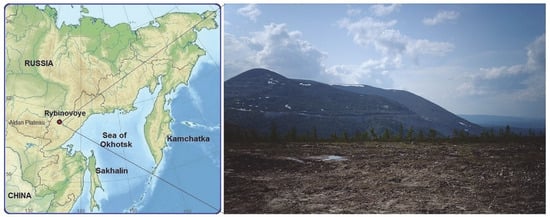
Figure 1.
The geographic location and photo of the Ryabinovoye deposit (photo by L.A. Lenev https://webmineral.ru/deposits/photo.php?id=4282, accessed on 13 May 2025).
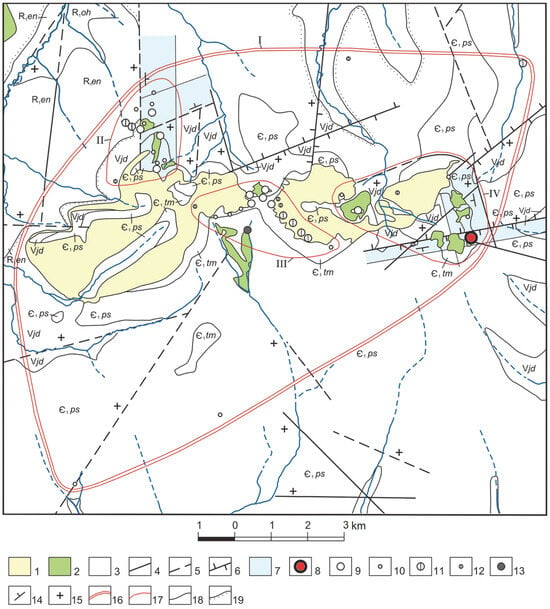
Figure 2.
Structural–metallogenic scheme of the gold ore cluster (based on data [62]). 1—derivatives of the Ket-Kap intrusive complex, which are paragenetically associated with gold mineralization (monzonites, quartz monzonites—μ3, qμ3K1k); 2—pre-metallic derivatives of the Ket-Kap intrusive complex (diorites, monzodiorite and their quartz varieties—δ2, μδ2, qμδ2K1k); 3—riphean-lower Cambrian terrigenous-carbonate deposits (??) of the platform cover (omakhtinskaya—R1 oh, enninskaya—R1 en, yudomskaya—V jd, pestrotsvetnaya—Є1 ps, tumuldurskaya—Є1 tm formations); 4–6—discontinuities: discovered (4), assumed from geological (5) and geophysical (6) data; 7—flexures in sedimentary formations; 8–13—gold ore objects: skarn deposits (8), ore occurrences (9), mineralization points (10); hydrothermal ore occurrences (11) and mineralization points (12); ore occurrences of unclear genesis (13); 14—bedding of rocks on the flexure ledge; 15—relatively elevated block of rocks along the discontinuity; 16–17—contours of metallogenic taxons: Tassky (I) gold ore cluster (16) and ore fields (17)—Tarannakh (II), Vodorazdel (III), Ryabinovoye (IV); 18–19—contacts of stratified formations: concordant (18) and stratigraphically nonconcordant (19).
The presence of dolomites and magnesian limestones in the underlying and enclosing strata led to the formation of Ca, Ca-Fe, Ca-Mg, and Mg silicates. This polymineral composition of calcic skarns suggests that the intrusion formed in hypabyssal conditions at depths of up to 3–4 km [43] or, according to geological data, up to 1–1.5 km from the paleosurface [62,63]. The altered rocks of the deposit are composed of contact-metasomatic formations associated mostly with monzodiorite dikes and, to a lesser degree, with the contact of the main intrusion.
The zones of near-contact changes are 300 m wide [61,62,63]. The endoskarn rim in the intrusion is thin (up to 2 m), but the veins of skarn minerals may develop in up to 50 m wide bands. This rim includes associations of garnet and diopside with an admixture of epidote and magnetite, overlain by later sulfide mineralization (mainly pyrite, with a drastically subordinate amount of pyrrhotite and chalcopyrite). The boundaries between the monzodiorite, marble, and tremolite–diopside skarns are well-defined. The products of contact metamorphism at the deposit include marbles, hornfelses, and skarns. The predominant products of this process are fine–medium-grained (rarely coarse-grained) white, grayish-white dolomite, and dolomite–calcite marble. Quartz and biotite–quartz hornfelses are found in small quantities. Dolomites and limestones have undergone marbleization, and siltstones and sandstones of the Tumuldurskaya and Pestrotsvetnaya formations have undergone hornfelsization. The width of the skarnation halo in the sedimentary rocks of the Tumuldurskaya formation is no more than 150 m. The degree of rock metasomatic transformation varies from slightly noticeable to complete replacement of the substrate with newly formed minerals.
In terms of composition, two main mineral varieties of skarns, which are host rocks for gold mineralization, are distinguished. The pyroxene–garnet skarns are developed directly in the contact zones of intrusive and carbonate rocks. In marbleized calcareous dolomites of the upper subformation of the Tumuldurskaya formation, apocarbonate tremolite–diopside skarns make up about 90% of the deposit volume and are the main ore-bearing rocks. These are gray–white, light gray, greenish-light gray rocks of massive, less often spotted and banded texture, irregularly grained—from fine- to giant-grained rocks.
The Ryabinovoye deposit includes three main ore bodies, bordering (discontinuously) the monzodiorite intrusion from the north and east, associated with the exoskarn zone of carbonate rocks of the upper subformation of the Tumuldurskaya formation (Figure 3). The contours of the ore bodies, in most cases, coincide with the boundaries of the deposits of tremolite–diopside skarns. In some cases, the ore contours include adjacent marbleized carbonate rocks up to a few meters thick, which is due to the presence of small nests of gold-bearing skarns up to a few tens of centimeters in size. The ore bodies have a complex morphology in the form of lenticular deposits complicated by apophyses, numerous small protrusions, and ore-free parts in marginal zones (Figure 3) [23,62]. The apophyses branching from the ore bodies are characterized by an alternation of up to 1–2 m sharp pinches and 8–16 m thick swells, as a result of which the ore body looks similar to a chain of several lenticular and nest-like deposits, linked at the lower horizons by a 0.5–3 m thick ribbon-shaped vein. Satellites, which are hollow lenticular bodies ranging in size from a few meters to 17 × 12 m, located 2–14 m away, frequently accompany the main ore bodies. Smaller isolated ore nests and lenses also occur at a distance from the main ore body. In addition, small ore pockets are observed in the lower horizons of the upper subformation in isolation from the intrusion or in contact with it. Gold distribution is extremely irregular, even within the lenticular ore bodies. Gold contents in the ores vary from 6 to 300 g/t with zones of drastic enrichment up to several kg/t [61,62,63].
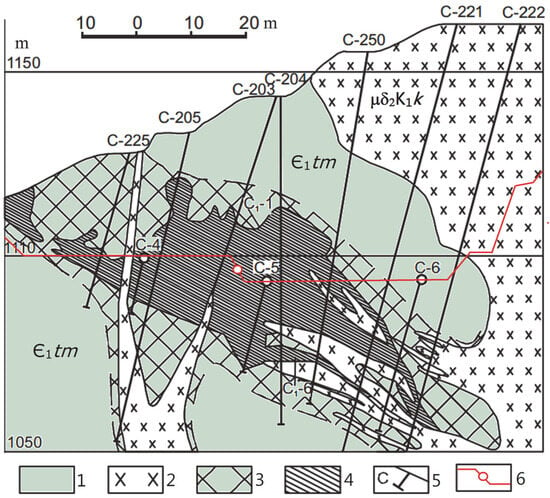
Figure 3.
Geologic section of the Severnoye ore body, Ryabinovoye deposit (based on data from [23,62]. Notations: 1—Lower Cambrian carbonate sediments (Є1 tm), 2—Early Cretaceous monzodiorites (μδ2K1k), 3—skarns, 4—ore body, 5—column wells and their numbers, 6—outline of the open pit 1 and sampling site.
The Severnoye ore No. 1 is the largest in terms of gold reserves and contains 76.8% of the total gold reserves of the deposit. It comprises an isometric lenticular deposit of tremolite–diopside skarns, which is slightly inclined towards the intrusion. The skarns include a series of gently sloping and steeply dipping monzodiorite dikes with locally developed garnet–pyroxene skarns around them (Figure 3).
The shape of the ore body is complicated by apophyses and numerous small protrusions. The largest apophysis is an individual outcropping lens connected to the main body by a ribbon-shaped vein about 25 m long, 4–15 m wide, and 4–7 m thick. The sole of the ore body mainly coincides with the boundary of the upper and lower subformations of the Tumuldurskaya formation. The Severnoye ore body is composed of ~90% of its volume of apocarbonate tremolite–diopside skarns, in which the proportion of diopside is 60–95% and tremolite is 5–20%. The water-bearing minerals (talc, chlorite, and epidote) are rarely noted as microinclusions.
Gold content within the Severnoye ore body is 18.5 to 29.4 g/t, averaging 23.6 g/t and decreasing to 5.0–13.2 g/t in the wedging zone [23]. Native gold is high fineness (986–999‰), with the admixtures of silver, copper, and zinc [23]. The morphology of native gold is characterized by a great variety of shapes: submicronic needle-shaped gold particles, both scattered and assembled into sheaf-like aggregates, faced cubic and octahedral microcrystals, and socket-like aggregates. These morphological varieties are present together [22].
The specific feature of the Ryabinovoye deposit is the overlapping of the ore body contours with the boundaries of tremolite–diopside skarns, a rather homogeneous mineral composition of the ore (predominant diopside with tremolite and calcite), and the absence of superimposed mineralization. The only mineral of gold is native gold. The ore bodies (lenses and nests) are localized in marble and have no direct contact with intrusive bodies, and feeding channels supplying the substance are also absent. The Ryabinovoye deposit can be regarded as a rather simple model system for studying the genetic processes of local gold concentration in which the number of input parameters is minimal.
3. Materials and Methods
3.1. Samples
In this work, we studied lump ore samples from the Ryabinovoye deposit, taken from the open pit of the Severnoye ore body (Figure 3). Fragments with visible gold were chosen from a collection of 12 samples of tremolite–diopside skarns ore. Polished sections of selected fragments were obtained after grinding and polishing the surfaces with alcohol emulsions of diamond pastes with decreasing grain size, followed by further washing of the surface with ethylic alcohol.
To determine the morphological diversity, microstructural features, and boundaries at the contact interactions of native gold with host minerals, the surface of some polished sections was subjected to selective chemical dissolution using diluted and concentrated acids (HCl and H2SO4). Diopside and tremolite are chemically stable and are extremely weakly dissolved in acids. Calcite easily dissolves in both acids. Its removal from the surface is easily controlled during dissolution, using HCl of varying concentration and exposure time. The reaction products practically do not produce undesirable effects and artifacts on the exposed surface. To dissolve fluorite and partially magnetite, H2SO4 was used. Native gold is resistant to these reagents. Residual reaction products after acid treatment of the described mineral association are easily removed from the surface by washing in distilled water and ethylic alcohol.
We also analyzed individual particles of native gold obtained as a result of complete dissolution (after treatment by acids HCl, H2SO4, and HF) of the host minerals in lump ore samples.
3.2. Methods
The research was carried out using a scientific and analytical basis of the Laboratory of Microscopy and Structural-Molecular Studies in the Amur Centre of Mineral-Geochemistry Investigation in the Institute of Geology and Nature Management by the methods of optical microscopy in reflected (Nikon SMZ645 microscope, Tokyo, Japan) and polarized light (Axio Skope A1 microscope, Zeiss, Oberkochen, Germany), a few types of scanning electron microscopes (SEM): LEO (Zeiss, Jena, Germany), JSM-6390LV JEOL, equipped with a joint microanalysis system INCA Energy 350 and INCA Wave (Oxford Instruments Ltd., Abingdon, UK) (WDS), SIGMA (Zeiss, Jena, Germany) equipped with AZtec X-Max 80 microanalysis system (Oxford Instruments Ltd., Abingdon, UK) (EDS).
Modes of imaging (accelerating voltages of 10–20 keV, working distances, signal detection, and sample tilt) and processing were chosen depending on the task and features of the samples. Microimages were obtained in the modes of the secondary (SE) (contrast because of topography), reflected (BSE) (compositional contrast because of the differences in the average atomic number of phases), and mixing of signals from secondary and reflected electron sensors (BSE + SE). X-ray spectral determinations of the chemical composition of phases were carried out by points and rectangular microregions, as well as by the scanning area (full frame) in the form of maps of the distribution of characteristic X-ray radiation of certain wavelength intervals, taking into account the effect of superposition of peaks from different elements.
To control the probe current and energy shift of the registered spectrum, calibrations on metallic cobalt were used. The time required for collecting spectra was 100 s for native gold and 60 s for associated minerals. The lower detection limits for elements were tenths of a percent. The analyses were performed on each of the polished sections. We analyzed both the core and the rim of each gold grain of a size more than 5 µm. The results were processed using the XPP method in Software INCA 4.17, INCA 5.04, and Aztec 2.0 (Oxford Instruments Nanotechnology Tools Limited, Abingdon, UK) programs.
X-ray diffraction studies were carried out using a set of equipment: XRD-7000 MAXima. X diffractometer (Shimadzu Corporation, Kyoto, Japan) with an X-ray tube of Cu-anode with a long fine focus (PW2273/20, 2.2 kW (Philips, Amsterdam, The Netherlands, Cu λ 1.5405, Cu Target, Long Fine Focus (LFF) Type, 2.2 kW) and a CM-3121 diffracted beam monochromator with a MDA-1101 microscope unit with 1.00 mm locality area and using a non-reflection cuvette for microsamples; an X-ray microdiffractometer, D8 Discover, (Bruker AXS, Ettlingen, Germany) on CuKα-radiation with a graphite monochromator with the area of locality up to 0.07 mm, with rotation, with oscillation and by points (CKP DVGI FEB RAS); and by photomethod on the X-ray structural unit URS-2 (CuKα-radiation with Ni filter), RKD-57.3 camera with sample rotation. The lattice parameters were refined with the least-squares method, using all reflections available from measurement. The results were processed using the Software XRD (DLAT 2.6, DPFIT 2.0, crystallite size and lattice strain DCRL 2.6 (Shimadzu)) and Siroquant 4.0 (Sietronics Pty. Ltd., Mitchell, Australia) programs.
4. Results
4.1. Minerals of Gold-Bearing Apocarbonate Tremolite–Diopside Skarns
4.1.1. Minerals of Apocarbonate Skarns
Geological exploration data indicate [62,63] that 90 vol.% of the Ryabinovoye ore deposit are apocarbonate tremolite–diopside skarns, in which 60–95% is diopside, 5–20% tremolite, up to 5% minor minerals, and no more than 0.5%. Chemical composition of the main gold-bearing skarn minerals (in wt.%): SiO2—52.3, TiO2—0.016, Al2O3—0.77, Fe2O3—2.4, CaO—19.3, MgO—21.34, MnO—0.76, K2O—0.04, Na2O—0.52, P2O5—0.03, S—0.048, and LOI—3.06.
Microscopic and X-ray spectral studies of the thin sections of gold-bearing tremolite–diopside skarns showed that diopside is predominant in their composition with no less than 75 mol.% (rarely the diopside–hedenbergite solid solutions (Mg > Fe)). It forms pale, dirty green, and gray, dense clusters of grains up to 0.2 mm in size, resulting in a massive mosaic structure (Figure 4). Diopside constantly contains Fe, occasionally Mn and Al (Table 1). Diopside grains contain rare phenocrysts of magnetite, hematite, and apatite. Local microscopic reacting zones composed of the minerals tremolite, talc, chlorite, epidote, and local isolations of redeposited carbonates are observed along the boundaries and in structurally not dense areas of individual diopside grains (Figure 5 and Figure 6). The tremolite content is about 15 mol.%. It forms compact clusters (nests and phenocrysts) in the structural mass of granular diopside in the form of diversely oriented aggregates of long-prismatic, axially elongated, parallel-columnar-shaped to needle-shaped and fibrous crystals, radial–axial and sheaf-shaped aggregates of white and grayish-white color. Tremolite also consistently contains Fe, occasionally Al, K, and Na impurities. Fluorine in the composition of tremolite is not rare (Table 1).
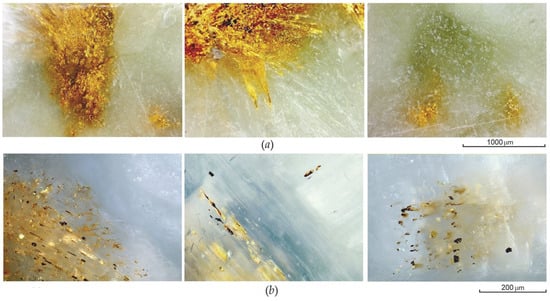
Figure 4.
Microphotographs in reflected (a) and polarized (b) light of the surface of polished sections of tremolite–diopside skarns with visible native gold.

Table 1.
Chemical composition of the main gold-bearing skarn minerals (wt.% and formula).
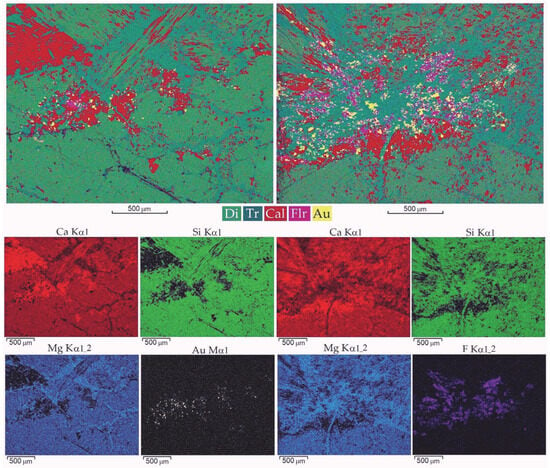
Figure 5.
Distribution of mineral phases—diopside, tremolite, calcite, fluorite, and native gold in the zones of tremolite compact accumulations. Images obtained in the reflected electron mode with superimposition of maps of distribution of characteristic X-ray radiation, and distribution maps of the corresponding chemical elements over the scan area. Note: diopside (Di), tremolite (Tr), calcite (Cal), fluorite (Flr), native gold (Au). Here onwards, mineral abbreviations are given in accordance with the recommendation of the International Mineralogical Association [64].
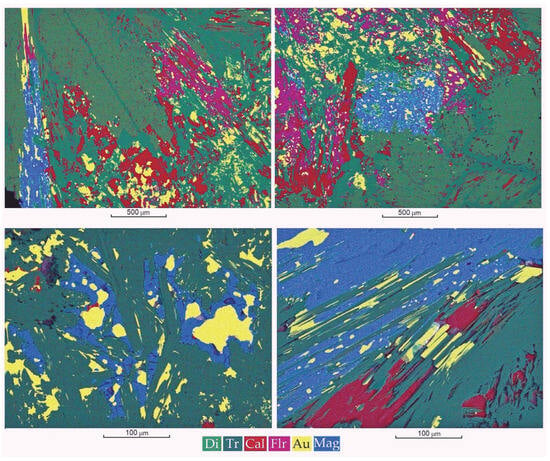
Figure 6.
Distribution of mineral phases in the zones of tremolite (Tr) compact accumulations with magnetite (Mag), native gold (Au), diopside (Di), calcite (Cal), and fluorite (Flr). Images obtained in the reflected electron mode with superposition of maps of distribution in characteristic X-ray radiation.
The concentration of calcite is also significant, up to 7 mol.%. It occurs among diopside grains, but its major part is adjacent to tremolite zones, in which it, together with fluorite, fills intercrystalline spaces and fringes the boundaries between tremolite and diopside in the transition zone from granular diopside to accumulations of tremolite crystals and aggregates. The intergranular spaces of diopside contacting with the zone of mutual tremolite–diopside intrusion are filled with hidden crystalline tremolite (Figure 5 and Figure 6). Such mineral association dominated by irregular-grained diopside and crystalline tremolite forms a radial–axial structure at a microlevel.
Native gold and magnetite are concentrated in tremolite isolations that form zones of significant local enrichment (Figure 4, Figure 5 and Figure 6). Other silicates and ore minerals (wollastonite, clinohumite, phlogopite, epidote, chlorite, cryptomerous and fine-crystalline quartz, hematite, Fe-bearing sphalerite, pyrrhotite, pyrite, galena, and chalcopyrite) also occur in the tremolite-rich zones.
4.1.2. Chemical Composition of Native Gold
According to the results of rational analysis [63], the content of free gold in tremolite–diopside skarns, when crushed to −0.074 mm, is 92%, while the content of finely disseminated gold in rock-forming minerals is 8%. In the −1 + 0.074 mm class, the refractory gold accounts for 30.4%, and in the −0.074 mm class, only for 5%. The gold content in the contours of ore bodies ranges widely from 0.1 to 432.0 g/t. The average Ag/Au ratio is 1:10.7.
The electron microprobe analyses of native gold of tremolite–diopside skarns from the Ryabinovoye deposit show its high fineness (above 970‰). Native gold containing minor concentrations of Ag (<1.59 wt.%) predominates, and impurities of Cu (<0.37 wt.%) and Zn (<0.15 wt.%) are less common (Table 2). The average fineness (NAu = Au × 1000/(Au + Ag + Cu + Zn)) is 993‰. The fact that the low-intensity peaks of the predominant elements in the system are present in the energy dispersive spectra is explained by the subtle mutual penetration of mineral phases into each other. Most native gold contains a large number of inclusions of silicate and ferruginous composition. It is possible that zinc occurs as ultrafine phases in the porous structure of native gold.

Table 2.
Chemical composition (wt.%) and fineness of native gold (‰) (selective data *).
Thus, the ores are represented by dense, massive rocks dominated by granular diopside with nests of tremolite with native gold, calcite, fluorite, magnetite, and small amounts of sulfides and silicates. The character of localization and distribution of native gold in the ores is determined by the crystallization of the tremolite component of rocks.
4.2. Morphological and Microstructural Features of Native Gold of Apocarbonate Tremolite–Diopside Skarns
4.2.1. Contact Interactions of Native Gold and Skarn Minerals
As was mentioned above, native gold is concentrated in the nests formed by local accumulations of tremolite crystals into mass rocks composed of irregularly grained diopside (Figure 5 and Figure 6). The shape and structure of the nests are determined by a stable set of main mineral phases and forms of their crystallization.
Calcite is the third most important mineral in gold-bearing tremolite–diopside skarns. It was found both in the form of relict micrograins interstitial to diopside grains and in the form of remobilized mineral filling of intercrystalline spaces of tremolite. Calcite accumulates along the boundaries of tremolite nests in the transition zones between diopside and tremolite (Figure 5 and Figure 6).
The analysis of electron microscopic data shows that native gold is associated with all minerals of tremolite nests (Figure 7). It was found along the boundaries of intergrowths of tremolite crystals and diopside grains, forming interpenetrating transition zones at the nest boundaries in direct intergrowth with tremolite crystals (Figure 7a,b). Gold fills multi-scale voids formed by the multidirectional growth of tremolite crystals and the intercrystalline spaces of its sheaf-shaped aggregates (Figure 8). It is present in calcite and fluorite (Figure 7c,d), aggregates with magnetite (Figure 9), sphalerite (Figure 7c), and contains microinclusions of sulfides (pyrrhotite and galena), clinohumite, and other magnesian silicates, and also forms tremolite–gold microheterogeneous aggregates (Figure 8).
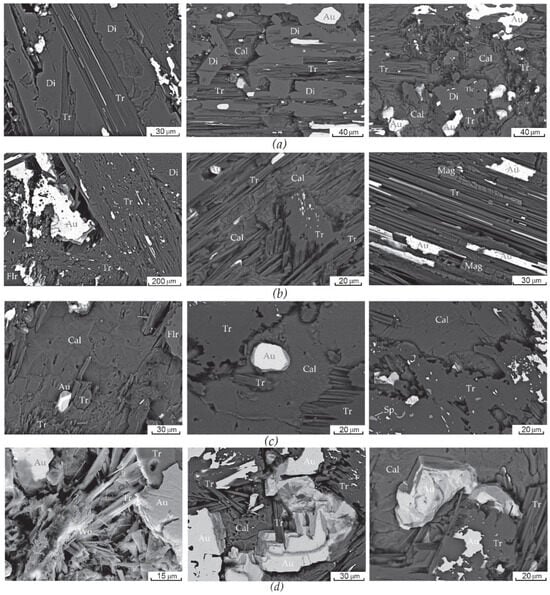
Figure 7.
Morphology of native gold (Au) and features of contact interactions with diopside (Di), tremolite (Tr), calcite (Cal), fluorite (Flr), magnetite (Mag), wollastonite (Wo), and sphalerite (Sp): transition zone from diopside grains to tremolite segregations (a), multidirectional growth of tremolite crystals and its aggregates (b), gold grains exposed after dissolution of calcite (c,d).

Figure 8.
Morphostructural features of gold particles deposited at the contact with tremolite crystals. Mixed images of signals from secondary and reflected electron sensors (BSE + SE).
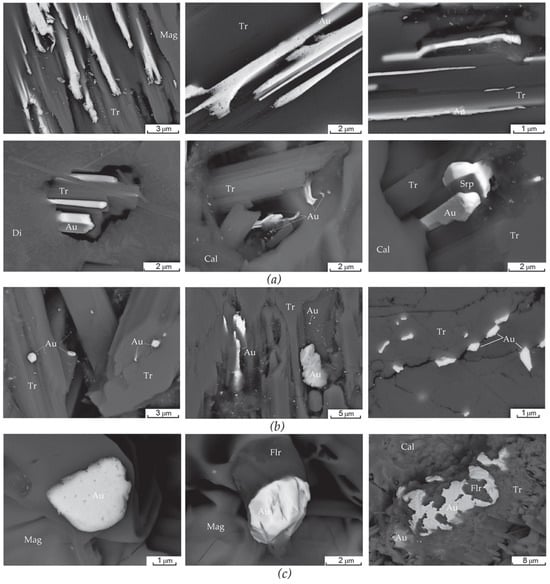
Figure 9.
Morphological and microstructural features of gold (Au) microparticles intergrown with diopside (Di), tremolite (Tr), calcite (Cal), fluorite (Flr), magnetite (Mag), and serpentinite (Srp): change in the shape of needle-shaped gold particles during the transition from the zone of limited growth (intercrystalline spaces of tremolite) to the zone of free growth (a), gold particles on the growth points of tremolite crystals and in the intergranular space of structure-less tremolite (b), magnetite and fluorite (c). Morphostructural features of gold particles at the contact with tremolite crystals. SE, BSE images.
Long-prismatic, parallel-columnar to needle-shaped and thread-like tremolite crystals and their sheaf-shaped aggregates, in the mutual arrangement of which there are no preferential growth orientations, form a spatial structure with a large volume of voids (Figure 7 and Figure 8). Intergranular voids of tremolite are filled with calcite, fluorite, magnetite, native gold, and other ore and non-metallic minerals (Figure 6 and Figure 7).
For the most part, native gold in association with tremolite is represented by elongated individuals that inherited the morphology of tremolite crystals and aggregates to varying degrees (Figure 7, Figure 8 and Figure 9). There are individuals with a relief-ribbed surface parallel to the long axis, which are formed in larger voids because of sticking to their inner walls formed by intergrowing sheaf-like aggregates with dense stacking of thread-like tremolite crystals. In many cases, as a result of the filling of a significant part of intergranular spaces of sheaf-like aggregates with gold, polyphase individuals are formed, in which the proportion of metallic and silicate phases is comparable.
As needle-shaped gold individuals emerge from the zone of growth controlled by tremolite crystals, they can flatten, branch, and bend. Gold is also deposited on various elements of the surface of dense crystals (protrusions, depressions, caverns) and in the intergranular space of structureless tremolite (Figure 9).
4.2.2. The Contact Interactions of Native Gold and Magnetite
Native gold, in association with magnetite, has peculiar features. Magnetite forms uneven dissemination in tremolite nests (Figure 6). It is concentrated in the local rounded segregations, which are penetrated by clusters of tremolite crystals with needle-shaped gold. (Figure 6 and Figure 10). Magnetite also forms denser segregations whose shape is determined by the space limited by tremolite and diopside. Owing to space constraints during crystallization, dense magnetite segregations acquire elongated shapes. The presence of needle-shaped individuals of gold in magnetite is associated with the intergrowth of gold in tremolite, which penetrates magnetite. Passing from tremolite into the intergranular space of magnetite, gold needles become overgrown with submicron gold particles. Gold localized in the intergranular spaces of magnetite has uneven outgrowths with fine penetration into magnetite (Figure 10).
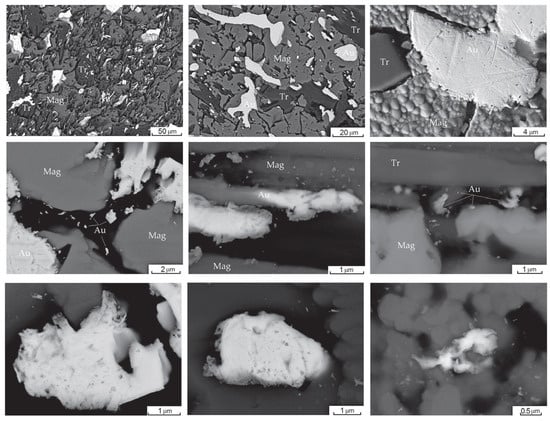
Figure 10.
Morphological and microstructural features of gold microparticles associated with magnetite (Mag) and tremolite (Tr). BSE images.
4.2.3. Microstructural Features of Native Gold
Fine-phase heterogeneity in the form of submicroscopic inclusions of silicate phases is frequently observed on the polished surfaces of gold particles (Figure 8 and Figure 11). The shape of prismatic and rounded gold needle-shaped crystals in the intercrystalline spaces of silicate minerals is determined by the volume of available space for gold deposition and subsequent recrystallization processes, resulting in the induction surfaces on gold particles formed at contact with the host minerals. The needle-shaped gold individuals have cross-sectional dimensions of 100–600 nm, with a predominant size feature of~350 nm and lengths up to 150 nm (Figure 12). The gold grains are subhedral, not completely bounded by crystal faces, and are located at the boundaries of the intergrowth of hard silicate minerals and soft redeposited calcite. The appearance of crystal face surfaces is the result of both crystalline ordering of gold particles and contact interactions with the crystalline surface of tremolite with the formation of the induction surface on native gold grains (Figure 7, Figure 8 and Figure 9).
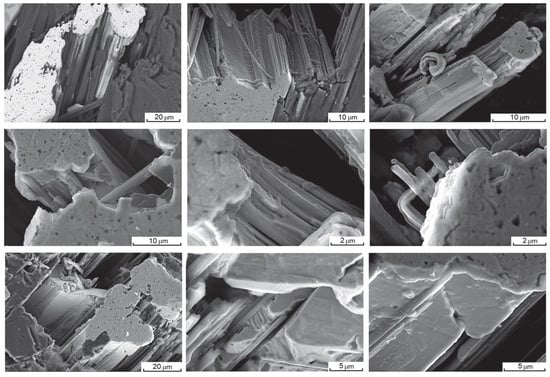
Figure 11.
Morphostructural features of native gold, determined using selective dissolution of host minerals. SE, BSE images.
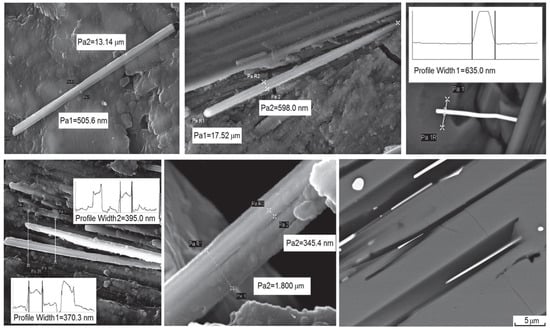
Figure 12.
Dimensional characteristics of needle-shaped crystals of native gold and their clusters. SE, BSE images.
Relatively large gold grains are intergrown with calcite and tremolite. They are characterized by the simultaneous presence of faces in some parts of grains and a thread-like substructure in others (Figure 11). Their formation is probably also associated with the filling of intercrystalline spaces of needle-shaped and thread-like aggregates of tremolite with gold and their subsequent recrystallization. They contain numerous inclusions of silicate phases observed on the polished surface. Thus, the morphostructural features of gold individuals in association with tremolite are determined by the structural and spatial distribution of tremolite crystals, forming the enclosing space for the deposition and recrystallization of gold.
The analysis of the electron micrographs of the surface after the dissolution of calcite shows that gold is also actively accumulated in calcite, without contact with tremolite. Individual grains of native gold associated with calcite frequently have partially or completely crystal faces (Figure 7 and Figure 13). They have well-defined crystal faces but often lack the edge and apical elements of the normal habit. This indicates that they are at an intermediate stage of recrystallization and ordering of the structure. Anhedral gold grains with openwork loose structure occur in calcite, too.
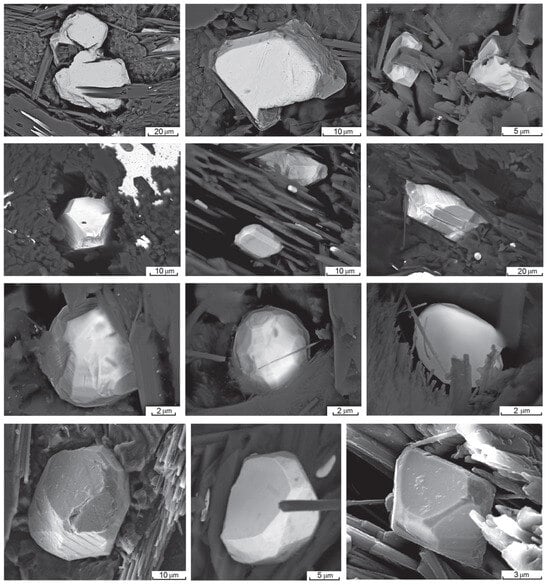
Figure 13.
Microcrystals of native gold of various habits, exposed by selective dissolution of host minerals. SE, BSE images.
The morphological diversity of particles with crystal faces is characterized by undeveloped apical and edge forms (Figure 13). The replacement of octahedron edges with concave dihedral sections leads to an octahedron shape with grooves on the edges, which are often observed, e.g., on diamond and platinum crystals. According to classical concepts, the absence of edge and apical forms on crystals is associated with the transfer of substance at an atomic level [65]. In one case, this is the dissolution of the most active zones of crystals and removal of substance; in the other, the supply of substance with hydrothermal solutions in the form of dissolved particles or complexes that can decompose near the surface of a growing crystal, or enter from a solid phase owing to atomic diffusion.
The analysis of the microstructure of gold particles at the intermediate stages of crystal formation (Figure 14) allows us to describe the formation mechanisms of gold polyhedrons. Such particles offer significant information from a genetic point of view, which can be used to reveal the mechanisms and processes of the origin and evolution of gold grains. The structural organization of these grains is based on the aggregation of globular particles with ordered arrangement. The geometric order in the arrangement of globules can lead to the formation of polyhedrons morphologically similar to those found in the studied samples. The process can proceed in the direction of compaction and fusion of globules with the formation of a polyhedron without edges and vertices (Figure 14a) or with clearly defined edges and vertices (Figure 14b).
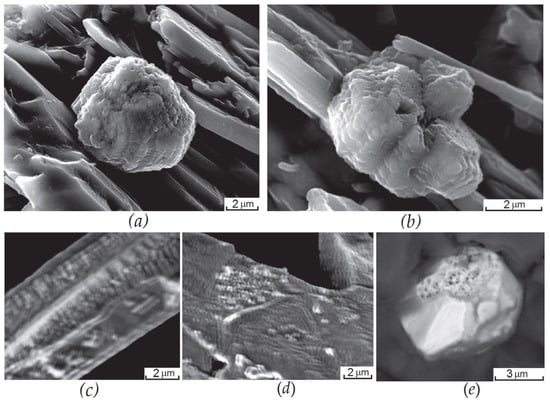
Figure 14.
Native gold with a globular substructure, elements of polygonization (a), and ordering of substructural units of future crystals (b). Substructure of gold surface: globular with elements of polygonization (c) and block with shagreen surface (d). Internal nanoporous structure of gold crystals (e). SE, BSE images.
Detailed studies of the substructure of elongated gold grains showed that their structural organization is also based on the aggregation of globular particles that form columnar formations (Figure 14c). It is worth noting that the surface of needle-shaped and long-prismatic crystals also has elements of a similar ordering. The most common size of globules is 30–60 nm, and larger globules of ~300–600 nm are composed of small ones. The predominant size of the globules that make up the intermediate forms of grains with distinct crystal faces described above is 300 nm (Figure 14a,b), which also corresponds to the most common transverse size of needle-shaped crystals. In the arrangement of columnar formations formed in the process of aggregation of globular subindividuals, ordering occurs with the separation of the block structure (Figure 14d). Within the blocks, the arrangement of columnar formations is close to concordant.
In most gold grains, zones with the relics of a globular structure are observed. The microstructure of native gold is formed by successive aggregation of globular particles with subsequent accretion, compaction, and formation of a surface layer. At the same time, there are both relatively loose structures with clearly visible boundaries of the constituent particles and grains with pronounced smooth edges, as well as a significant number of intermediate forms. There are individual gold particles with crystal faces, but their internal structure remains nanoporous (Figure 14e). This implies that, though they are external crystals, no real ordering in gold particles occurred. Thus, regardless of whether the grains of native gold were formed from needle-shaped crystallites or have a crystalline facet, their internal structure is not dense.
The presence of such particles on the surface of various minerals supports the assumption that gold individuals of various configurations are formed from nanosized particles. They can be dispersed in minerals or form local clusters (Figure 15). Gold microcrystals are formed by the aggregation of smaller particles, while subsequent processes of recrystallization and solid-phase ordering lead to the appearance of crystal faces on gold individuals. The phenomenon of successive aggregation, compaction, and recrystallization was also observed in the studies of the evolution of ultra-dispersed palladium and gold powders in free contact at room temperatures [66,67].

Figure 15.
Forms of separation and localization zones of submicron-sized gold particles (light particles in the micrographs). BSE images.
Several morphostructural groups are distinguished among the grains of native gold extracted from the crushed rock of tremolite–diopside skarns by chemical dissolution of host minerals (Figure 16). The most frequently observed aggregates are elongated individuals (ribbon, needle-shaped, and columnar) gathered in clusters. The second group consists of lumpy aggregates composed of smaller grains, the surface of some of which is covered with small overgrowths. Among the lumpy particles, there are denser individuals with residual relief elements of the primary substructure. Voluminous openwork aggregates of flattened subindividuals are also common (Figure 16c). The contacts of intergrowth between particles are weak, often pointwise. The substructure of particles that make up the grains has a varying degree of compaction, even within one grain. The central part of the grains is denser, and toward the periphery, the structural density of particles decreases, and spongy structures are formed. In addition, there are particles with directional compaction from one edge of the grain to another with the appearance of edges in the denser part, on which a pattern made up of the particles is visible.
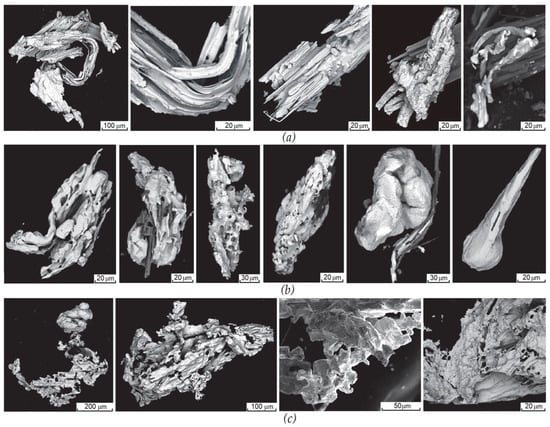
Figure 16.
Morphological and microstructural features of gold particles extracted by chemical dissolution from tremolite–diopside skarns: clusters of thread-like, needle-shaped, and flattened individuals (a), volumetric aggregates of various degrees of intergrowth of primary grains (b), openwork aggregates (c). BSE images.
In summary, the gold grains of apocarbonate tremolite–diopside skarn ore may be anhedral (exhibiting no crystal faces at all and with an openwork loose structure), subhedral (not completely bounded by crystal faces), euhedral, composed of flat faces on all sides and aggregates of needle-shaped and long prismatic crystals.
4.3. Structural Organization and Degree of Ordering of Gold Particles of Apocarbonate Tremolite–Diopside Skarns
The analysis of X-ray powder patterns obtained from native gold of openwork structure showed that they have a polycrystalline structure. The unit-cell parameters vary in the range of 4.076–4.078 Å, on average 4.0768(2) Å (Table 3). Diffraction broadening of reflexes, caused by a reduction in coherent scattering blocks, starts at crystallite sizes less than 103 Å. The lines on the X-ray powder patterns from the studied samples are thin and well-defined, with a split doublet (333), (511) (Figure 17). Thus, the size of crystallites of openwork gold (Figure 16c) is ~104–103 Å. The shape of peaks is close to symmetrical, lines with (hkl)h = k are approximated by the Lorentz curves.

Table 3.
Structural features and unit cell parameters of morphological varieties of native gold.
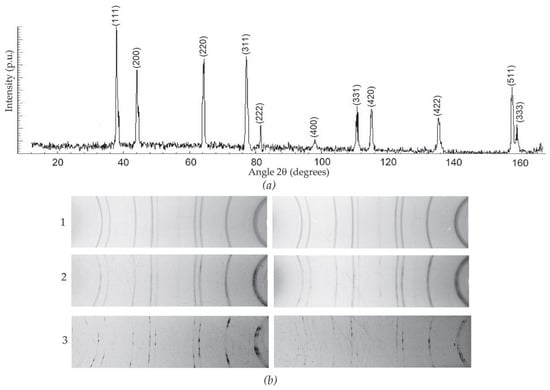
Figure 17.
X-ray diffraction patterns of native gold grains of tremolite–diopside skarns from the Ryabinovoye deposit, reflecting different degrees of their crystallinity: characteristic diffractogram of polycrystalline grains (a), X-ray diffractograms (debaegrams) of native gold with different sizes of blocks of coherent scattering and degree of crystallinity (b): 1—polycrystalline grains (size of blocks of coherent scattering is ~10–100 nm); 2—polycrystalline grains with elements of ordering (gold grains simultaneously contain phases of different dispersity: phases with sizes of coherent scattering blocks ~10–300 nm with the elements of substructural ordering and presence of phases with crystallite sizes less than 10 nm, with a halo in the region of small reflection angles (subcrystalline state)); 3—grains with a high degree of crystallinity with a block structure close to monocrystalline.
X-ray diffraction patterns of denser partially recrystallized native gold and individuals of native gold adjacent to the interfaces of silicate and carbonate minerals (Figure 16b) are characterized by the appearance of bright reflections over thin lines in the region of small angles. The ordering appears along separate directions, of which the (111) direction is predominant. Native gold in aggregates of needle-shaped crystallites (Figure 16a) has a similar diffraction pattern, but the reflexes over thin lines are more distinct and are closer to pointwise reflexes in terms of their localization. Reflections in the region of large angles are practically not blurred, and the doublets (511) and (333) are well split. The unit cell parameters for partially recrystallized gold individuals vary in the range of 4.077–4.0786 Å, averaging 4.0778(2) Å, and for gold needle-shaped aggregates—unit cell parameter is 4.0786(2) Å (Table 3).
Native gold with distinct facets has a diffraction pattern with the simultaneous presence of very thin lines on all reflections, and on top of these lines, brighter reflections are observed. In the region of small reflection angles, the reflexes are short and localized almost pointwise; with an increasing angle, the reflexes lengthen and gradually become blurred; the doublet (511), (333) is split but somewhat blurred because of the broadening of the lines. This diffraction pattern indicates the simultaneous presence of mutually ordered coherent scattering regions (CSRs), both relatively large (more than 50 μm) and small (less than 103 Å). The average elementary cell parameter is 4.0789(2) Å and ranges from 4.078 to 4.080 Å (Table 3).
A direct relationship between the unit cell parameters and the degree of crystallinity is observed. Despite the fact that all gold, irrespective of its morphology and degree of crystallinity, belongs to high fineness gold, its unit cell parameters range from 4.0761 to 4.0801 Å. Polycrystalline native gold, which has an openwork loose structure, shows the lowest values of the lattice parameter. Processes of compaction and ordering lead to a pronounced increase in this parameter. Grains with crystalline faces have maximum values—4.0801 Å. The unit cell parameter of 4.0786 Å, characterizing gold (99.9999%) obtained from the melt, coincides with the cell parameters for partially recrystallized grains and aggregates of needle-shaped crystallites.
The sizes of the coherent scattering regions (CSR) were determined for different morphostructural varieties of native gold (Table 4). Loose openwork grains have the smallest sizes of ~30 nm. For dense particles with different ordering elements, the sizes of CSRs increase. As there is a stepwise increase in the CSR ~30, ~60, and ~90 (100) nm, it can be assumed that particles with high CSR values result from mutual ordering and fusion of particles of a smaller scale level. The next scale level of sizes of coherent scattering regions (crystallites) is ~300 nm, further ~600 nm, then 1–3 µm.

Table 4.
The values of the integral width βs of the diffraction peaks and the size of the RCS-D determined by the Scherrer formula [69].
The analysis of the ideal crystal structure of single crystal grains by the Schultz method [42] revealed the presence of disoriented blocks in the crystal structure, which are substructural components of two orders—100 and 300 nm for crystals with sizes up to 100 µm, and substructural components of three orders—100, 300 nm and 1 µm for crystals with sizes 100–300 µm. The sides of first-order blocks are orientated along the (100) direction of the crystal, while the second and third-order blocks are orientated perpendicular to it. The sizes of submicron components of the first, second, and third-orders and the angles of disorientation between them are given in Table 5.

Table 5.
Dependence of substructural characteristics of native gold crystals with different degrees of recrystallization.
Moreover, the diffraction pattern with the simultaneous presence of both thin solid lines and distinct reflexes is also characteristic of individuals with a dense structure in the central part, but toward the periphery, one can observe a gradual decrease in density and separation of some multidirectional outgrowths forming the outer boundary of the individual. Such individuals consist of phases with different degrees of crystallinity and the presence of monocrystalline and polycrystalline components. The adherence to an ordered, repeating arrangement of atoms within a crystal can be quite variable. As a result, a continuum from almost perfect to very poor order (coherency) can be found in gold crystals.
Thus, analysis of the diffraction data on gold particles extracted from tremolite–diopside skarn ore indicates the simultaneous presence of native gold at different stages of recrystallization. We have found gold grains with ultrafine polycrystalline structure, with a structural order close to monocrystalline, and with varying degrees of ordering of coherent scattering blocks. Many particles are at the intermediate stages of recrystallization with zones of substantial ordering and zones of ultradisperse structure.
5. Discussion
Many skarn deposits form at the contact between igneous intrusions and adjacent carbonate rocks. Extensive metasomatic exchange of chemical components leads to enrichment of carbonate rocks with Si, Al, Fe, Mg, minor and trace elements, and to the formation of Ca-rich silicates such as grossular–andradite garnet, diopside–hedenbergite, wollastonite, tremolite–actinolite, epidote, vesuvianite and other silicates, which may also contain F, Cl, and B [70].
The model of formation of ore-bearing skarns is described as a four-stage process [2,32,33,39,60]: high-temperature stage (900–650 °C—isochemical metamorphism, formation of marbles, ore-barren), medium-temperature (early 650–500 °C—formation without hydrous minerals (pyroxenes, wollastonite), ore-barren), late (500–400 °C—formation of hydrous silicates, magnetite and hematite, sulfides, quartz, calcite, ore-bearing) and low-temperature (400–150 °C—final hydrothermal stage with formation of the mineral association superimposed on the associations of previous stages, ore-bearing). In accordance with thermodynamic conditions and phase compositions of the substance, certain associations of skarn minerals are formed at each stage [71,72].
The analysis of the results obtained in this study and data on the geology of the gold skarn Ryabinovoye deposit [23,25,62,63] allows substantiation of the processes and mechanisms resulting in the nested concentration of native gold in tremolite–diopside skarns. Intrusive bodies formed in hypabyssal conditions at a depth of 1–1.5 km [62,63] serve as a convective high-temperature source. It produces a spatially expressed gradient thermal field and is a trigger of solid-phase differentiation of carbonate sediments that contain disseminated forms of gold (impurity elements, clusters, and nano- and microparticles). According to [62], the gold content in unaltered rocks is low, but its presence is observed almost constantly. In thermally metamorphosed carbonate rocks and in intrusive bodies, which were not affected by metasomatism, gold content is 0.1–1 ppm. Only the parts of dikes localized in ore bodies are characterized by a high gold content comparable to ores, while beyond the ore bodies, the gold content is low.
Inversion of the temperature gradient activates metamorphism processes in silica-bearing calcareous dolomites, which subsequently undergo the stages of ultradisperse destructuring accompanied by the release of CO2 and, in some reactions, H2O, increasing the partial pressure of gases and collective recrystallization with the formation of dense fine- to medium-grained (rarely coarse-grained) white–grayish dolomite and dolomite–calcite marble of relatively persistent composition. At later stages, CO2 is trapped by forming retrograde skarn minerals (epidote) in the form of gas inclusions [23]. In accordance with these data [23], early generations of primary gas inclusions occasionally contain a minor amount of aqueous solution with small crystals of solid phase. No new phases are formed in them during deep cooling. The later generation of fluid inclusions in epidote consists of a gas–liquid and a solid phases with the temperature of eutectic solutions −51÷−52 °C and the melting temperature at the end of melting of the ice phase ~4.5 °C, while complete homogenization is achieved at 500 °C. This implies that the process of skarn formation at the Ryabinovoye deposit could have taken place with the participation of a high-temperature (not less than 500 °C) fluid, in the salt composition of which calcium chloride (±K, Mg) played the leading role, at the total concentration of solutions about 7 wt.% NaCl eq.
Large-scale solid-phase metamorphism forms a moving front of recrystallization, the configuration of which is determined by the constraints introduced by the factor of gradient temperature field, local heterogeneity of mineral composition, and structural–textural elements of the carbonate formation (including discharge zones of substance, penetration of intrusive bodies, etc.). Breaking down and recrystallization of carbonates are accompanied by the displacement of the crystallization zone of solid, liquid, and gaseous phases (including scattered forms—impurity elements, clusters, and nano- and microparticles, with the presence of gold among them), which are not incorporated into the structural–textural organization of marble. They are pushed away by the crystallization front of marble and are localized in the form of unreacted zones, whose shape and size depend on the configuration of the crystallization front of the predominant mineral phase. This stage determines the mineral composition and shapes of ore bodies [23,25,62,63]. The ore bodies are mainly lenticular and nest-shaped, complicated by numerous small protrusions and apophyses, isolated and interconnected by banded leaders with swells localized by the marble bed in the upper subformation of the Tumuldurskaya formation (the bottoms of ore bodies mainly coincide with the boundaries of the upper and lower subformations). Less frequently, the ore bodies are vein-shaped, associated with fracture zones and contacts with dikes localized in the marble, and serve as a natural barrier to the spread of the crystallization front of the marble.
The next stage of differentiation is associated with the substance concentrated in the localized unreacted zones. It determines the mineral composition and structural–textural features of gold skarn tremolite–diopside ores, the formation of which, in accordance with the revealed mineral parageneses (pyroxene–garnet with wollastonite and wollastonite-free, garnet-epidote and pyroxene-epidote facies), is limited by the temperature range of ~800–350 °C at a total pressure of less than 1 kb [62]. The whole volume of localized isolations is under equally probable physicochemical conditions relative to the whole volume of involved rocks (temperature (~800 °C) and high partial pressure). The phase-chemical composition is characterized by the predominance of solid phases based on CaO, MgO, and SiO2, with rather significant amounts of Fe, F, CO2, H2O, and other elements (including Au) present in subordinate amounts. Under these conditions, anhydrous diopside with Fe admixture is the first to crystallize (diopside content in the lenticular bodies is 60–95 mol.% [62]). Crystallization of diopside grains occurs throughout the entire volume. The chemical composition of local zones corresponds to the conditions of selective crystallization. Mass crystallization of diopside grains produces local configurations of the crystallization front with the displacement of phases that do not participate in its crystallization (non-structural and redundant elements), resulting in many chaotically arranged nest-like unreacted zones in the granular diopside of the massive structure.
Solid phases containing CaO, MgO, and SiO2 also dominate in the mass of nest-shaped isolations, but the share of aqueous component H2O, as well as Fe, F, CO2, and Au, significantly increases. The presence of the aqueous component and the temperature decrease to ~550–400 °C provide conditions for the crystallization of tremolite [71]. It is separated in the form of differently oriented long prismatic, columnar, needle-shaped, and thread-like crystals, and their sheaf-like aggregates form a rigid framework with a large number of voids of micron and submicron sizes (tremolite content in lenticular bodies is 5–20 mol.%) [62]).
As during the crystallization of tremolite, the growth of crystals is individualized; no mass displacement and concentration of the substance uninvolved in its crystallization take place, it remains in the intercrystalline spaces of tremolite. The phase composition and its variations in local zones play an essential role in the deposition of mineral phases under these conditions. The dominant components in the residual mineral-forming medium are CaO, CO2, Au, Fe, and F, of which magnetite crystallizes first in the temperature interval of ~400–350 °C [72]. The fraction of Au, which occurs predominantly in a dispersed mineral form (clusters and nano- and microparticles) due to the successive separation of dominant phases in the local concentration zones, increases significantly. During the growth of sheaf-shaped acicular and thread-like aggregates of tremolite, a significant fraction of gold is preserved in its intergranular spaces. At this stage, magnetite forms emulsion phenocrysts between thread-like aggregates of tremolite with native gold; deposited denser masses preserve the relics of globular structure in the intercrystalline spaces of columnar tremolite crystals. In the interstructural spaces of magnetite, native gold is deposited, and microphases of sulfides and other minerals are formed in accordance with the local conditions of mineral formation (in accordance with the phase composition and thermodynamic conditions formed in each particular microscopic zone).
In the residual mineral-forming medium after crystallization of magnetite and, partially, native gold, the dominant components are CaO, CO2, Au, and F. The redeposited calcite and fluorite are formed in the temperature interval of ~320–220 °C [72], which fills the residual voids between the tremolite crystals. In the voids between the tremolite crystals there were grains of native gold deposited earlier, on which ultrafine gold particles dispersed in calcium carbonates are deposited. The concentration of ultradisperse particles, their aggregation, and subsequent recrystallization lead to the formation of grains with different degrees of crystallinity of the constituent subindividuals.
The main mechanism leading to the formation of the observed structural–textural organization of the substance at different scale levels from macro- to micron and submicron locations is the thermally activated sequential solid-phase differentiation of the substance, resulting in the redeposition and crystallization of new mineral phases depending on the physicochemical conditions in the zone of its localization.
The main source of gold accumulated in the ore bodies is its dispersed forms (atomic, cluster, and nano- and microparticles) redistributed in carbonate formations. Being a dispersed element, gold forms clusters and nanophases localized in the structural defects of dominant minerals, in intergranular spaces, or conserved by the amorphous mineral matrix. Thermal effects on the rocks containing disseminated gold cause large-scale solid-phase differentiation processes involving the breaking down of various phases and collective recrystallization, which form new mineral associations. This results in the massive directional displacement of clusters, and nano- and microphases of gold to structurally non-dense zones. Dissipation of energy accumulated under the thermal impact of intrusion on the carbonate substrate and exothermic reactions occurring in the crystallization medium leads to the large-scale displacement of the substance that does not participate in the crystallization of the dominant minerals in the system, including the gas and liquid components. It activates the processes of self-organization of the substance within ore zones (lenses, nests) and the release of phases stable in specific conditions [73,74].
The morphostructural diversity of native gold is due to its structural organization resulting from the accumulation of dispersed forms of gold (impurity elements, clusters, and nano- and microparticles) in local zones owing to their displacement from the crystallization field of dominant minerals, their subsequent compaction, merging and recrystallization, with the restrictions caused by the interaction with associated minerals. The needle-shaped, thread-like individuals of gold, despite their external crystalline habit, are forced growth forms. They inherit the morphology of tremolite crystals and aggregates to a varying degree. Partially or fully faceted individual gold grains are deposited in a relatively isotropic medium capable of compaction (redeposited fine-dispersed calcite). Amoeba-like and sponge-like individual gold grains are associated with globular minerals (magnetite), whose interstructural elements are filled with gold, due to which the surface of gold particles is complicated by amoeba-like microgrowths.
The microstructure of native gold is formed by the principle of sequential aggregation of nanoparticles followed by merging, compaction, and formation of the surface layer. Such a sequence of formation of individual grains of noble metals was observed during the solid-phase recrystallization of ultradisperse Pd powders [65]. Both relatively loose structures with pronounced boundaries of the constituent particles and grains with the faces of dense structures, as well as a considerable number of intermediate forms, are present simultaneously. Although, from the outside, they look similar to crystals, the real ordering of gold particles has not yet occurred. In the voids between the tremolite crystals there were already grains of native gold deposited earlier, on which ultrafine gold particles dispersed in calcium carbonates are deposited. The concentration of ultradisperse particles, their aggregation, and subsequent recrystallization lead to the formation of grains with different degrees of crystallinity of the constituent subindividuals. Thus, the study of the degree of crystallization of native gold grains with the shape of crystalline polyhedrons revealed that many of them are not monocrystals and have a low degree of crystallinity [75]. X-ray and neutron diffraction indicate that well-formed crystals of gold may be polycrystalline or have a diffraction volume that is structurally coherent (i.e., a single crystal), and part of it consists of crystals or crystal domains with different orientations. Having a large number of internal nanopores, gold accumulates energy, the subsequent dissipation of which is realized in various forms. So, regardless of whether the grains of native gold are formed from needle-shaped crystallites or have crystalline faceting, their internal structure remains non-dense, crystalline disoriented, preserving elements of polycrystalline structure.
6. Conclusions
The analysis of the morphology, microstructure, and fine structural organization of native gold with regard to contact interactions with associated minerals deposited in tremolite nests of skarn tremolite–diopside ores from the Ryabinovoye deposit allows the following conclusions:
1. The main source of gold accumulated in the ore bodies is its dispersed forms (impurities, clusters, nano- and microparticles) redistributed in unaltered carbonate strata;
2. The processes of gold accumulation, separation, and formation of gold individuals are caused by the thermal activation of solid-phase differentiation of carbonate sediments, in which a significant part belongs to the destructurization processes of initial mineral phases and collective recrystallization, which involves a significant volume of rocks with relatively homogeneous mineral composition and considerable predominance of one mineral phase (calcareous dolomites in marbleization and diopside in skarnation). The character of localization and distribution of native gold in ores is determined by the crystallization of the tremolite component of skarns;
3. The analyses of electron microscopic, X-ray spectral, and X-ray diffraction data indicate the simultaneous presence of native gold at different stages of recrystallization: from particles of ultrafine polycrystalline to ordered structure, close to monocrystalline, with different degrees of ordering of coherent scattering blocks and the presence of particles that are at the intermediate stages of recrystallization with zones of substantial ordering and zones of ultradisperse structure.
4. Individuals of native gold are formed in the process of aggregation of smaller particles, forming complex systems of mutual penetration in host minerals. This structure suggests a highly expanded surface with excess energy, the dissipation of which leads to a coordinated action of the constituent particles, expressed in ordering and recrystallization. This process is realized at all scale levels, which is reflected in the simultaneous presence of particles that are at different stages and characterize the observed diversity of morphological and structural forms of native gold. Relatively stable conditions with very slow heat dissipation allow the realization of faceted forms of native gold.
Author Contributions
Conceptualization, V.I.R. and G.A.P.; methodology, V.I.R.; investigation V.I.R.; resources, V.I.R.; data curation, V.I.R.; writing—original draft preparation, V.I.R.; writing—review and editing, V.I.R. and G.A.P.; visualization, V.I.R.; supervision, V.I.R.; project administration, G.A.P. All authors have read and agreed to the published version of the manuscript.
Funding
This research was carried out within the framework of the state assignment of the Institute of Geology and Nature Management of Far East Branch (Blagoveshchensk) (No 122041800127-8) and the Sobolev Institute of Geology and Mineralogy of Siberian Branch (Novosibirsk) (No. 122041400237-8) of the Russian Academy of Sciences financed by the Ministry of Science and Higher Education of the Russian Federation.
Data Availability Statement
Data are contained within the article.
Acknowledgments
We would like to express our gratitude to the chief geologist A.A. Danilov (Khabarovsk), for providing samples for research.
Conflicts of Interest
The authors declare no conflicts of interest.
References
- Meinert, L.D. Gold Skarn Deposits—Geology and Exploration Criteria. Econ. Geol. 1989, 6, 537–552. [Google Scholar]
- Ray, G.E.; Webster, I.C.L.; Ettlinger, A.D. The Distribution of Skarns in British Columbia and the Chemistry and Ages of their related Plutonic Rocks. Econ. Geol. 1995, 90, 920–937. [Google Scholar] [CrossRef]
- Wilson, G.C.; Rucklidge, J.C.; Kilius, L.R. Sulphide gold content of skarn mineralization at Rossland, British Columbia. Econ. Geol. 1990, 85, 1252–1259. [Google Scholar] [CrossRef]
- Myers, G.L. Alteration zonation of the Fortitude gold skarn deposit, Lander County, NV. Mining Eng. 1990, 42, 360–368. [Google Scholar]
- Ettlinger, A.D.; Meinert, L.D.; Ray, G.E. Gold skarn mineralization and fluid evolution in the Nickel Plate deposit, British Columbia. Econ. Geol. 1992, 87, 1541–1565. [Google Scholar] [CrossRef]
- Groves, D.I.; Goldfarb, R.J.; Gebre-Mariam, M.; Hagemann, S.G.; Robert, F. Orogenic gold deposits: A proposed classification in the context of their crustal distribution and relationship to other gold deposit types. Ore Geol. Rev. 1998, 13, 7–27. [Google Scholar] [CrossRef]
- Molchanov, V.P.; Moiseenko, V.G.; Zimin, S.S.; Ignatiev, A.V. Features of the origin of the Kumbay gold deposit (DPRK). Dokl. Earth Sci. 1999, 364, 668–670. (In Russian) [Google Scholar]
- Idrus, A.; Kolb, J.; Meyer, F.M.; Arif, J.; Setyandhaka, D.; Keply, S. A preliminary study on skarn-related calcsilicate rocks associated with the Batu Hijau porphyry copper-gold deposit, Sumbawa Island, Indonesia. Res. Geol. 2009, 59, 295–306. [Google Scholar] [CrossRef]
- Kim, E.-J.; Park, M.-E.; White, N.C. Skarn gold mineralization at the Geodo Mine, South Korea. Econ. Geol. 2012, 107, 537–551. [Google Scholar] [CrossRef]
- Chang, Z.S.; Shu, Q.H.; Meinert, L.D. Skarn deposits of China. Soc. Econ. Geol. Spec. 2019, 22, 189–234. [Google Scholar]
- Rafailovich, M.S.; Shevchuk, S.I. Zolotonosnye skarny Central’noj Azii. Geol. I Ohr. Nedr 2010, 1, 23–34. (In Russian) [Google Scholar]
- Brooks, J.W.; Meinert, L.D.; Kuyper, B.A.; Lane, M.L. Petrology and geochemistry of the McCoy gold skarn, Lander County, NV: Geology and ore deposits of the Great Basin. Geol. Soc. Nev. Symp. Reno. Proc. 1990, 1, 419–442. [Google Scholar]
- Fontboté, L.; Vallance, J.; Markowski, A.; Chiaradia, M. Oxidized Gold Skarns in the Nambija District, Ecuador. Econ. Geol. Spec. Publ. 2004, 11, 341–357. [Google Scholar]
- Gusev, A.I. Geology and gold-copper-skarn mineralization of the Sinyukhinsky ore field in the Altai Mountains. Ores Met. 1998, 2, 79–90. (In Russian) [Google Scholar]
- Yurgenson, G.A. Mineral raw materials of Transbaikalia Chita: Poisk, 2006. 255p. SBN: 5-93119-157-7. (In Russian)
- Voroshilov, V.G. Geochemical zoning of skarn-gold ore deposits of Western Siberia. Bull. Tomsk Polytech. Univ. 2007, 310, 12–16. [Google Scholar]
- Gusev, A.I. Typization of gold-bearing skarns objects of mountain Altai. Advances in current natural sciences. Geogr. Sci. 2013, 11, 108–112. [Google Scholar]
- Kovalev, K.R.; Kalinin, Y.A.; Turkina, O.M.; Gimon, V.O.; Abramov, B.N. Kultuminskoe gold–copper–iron–skarn deposit (Eastern Transbaikalia, Russia): Petrogeochemical features of magmatism and ore-forming processes. Russ. Geol. Geophysics. 2019, 60, 583–601. [Google Scholar] [CrossRef]
- Gas’kov, I.V. New data on the correlation of skarn and gold mineralization at the Tardan deposit (northeastern Tuva). Russ. Geol. Geophys. 2008, 49, 923–931. [Google Scholar] [CrossRef]
- Soloviev, S.G.; Kryazhev, S.G.; Dvurechenskaya, S.S.; Uyutov, V.I. Geology, mineralization, fluid inclusion, and stable isotope characteristics of the Sinyukhinskoe Cu-Au skarn deposit, Russian Altai, SW Siberia. Ore Geol. Rev. 2019, 112, 103039. [Google Scholar] [CrossRef]
- Buryak, V.A.; Bakulin, Y.I. Metallogeny of Gold; Dalnauka: Vladivostok, Russia, 1998; 403p. (In Russian) [Google Scholar]
- Palazhchenko, V.I.; Stepanov, V.A.; Danilov, A.A. Mineral assemblage in gold-bearing skarns of the Ryabinovoe deposit, Khabarovsk district. Dokl. Earth Sci. 2005, 401, 478–483. [Google Scholar]
- Goroshko, M.V.; Guryanov, V.A.; Berdnikov, N.V.; Kirillov, V.E. Gold potential of the volcanoplutonic zones in the southeastern Siberian platform and physicochemical conditions of the deposit formation. Russ. J. Pac. Geol. 2009, 3, 511–529. [Google Scholar] [CrossRef]
- Soloviev, S.G.; Krivoshchekov, N.N. Vostok-2 gold-base-metal-tungsten skarn deposit, Central Sikhote-Alin, Russia. Geol. Ore Depos. 2011, 53, 478–500. [Google Scholar] [CrossRef]
- Sobolev, A.A. Current state of development of small-scale gold ore deposits in Khabarovsk Krai. Min. Inf. Anal. Bull. 2013, 11, 176–183. [Google Scholar]
- Volkov, A.V.; Sidorov, V.A.; Sidorov, A.A. Gold–Skarn Deposits in Northeast Russia. Dokl. Earth Sci. 2008, 419, 210–213. [Google Scholar] [CrossRef]
- Meinert, L.D. Skarn and skarn deposits. Geosci. Can. 1992, 19, 145–162. [Google Scholar]
- Zharikov, V.A. Skarn deposits. In Genesis of Endogenous ore Deposits; Nedra: Moskow, Russia, 1968; pp. 220–302. (In Russian) [Google Scholar]
- Sinyakov, V.I. Genetic Types of Skarn Ore-Forming Systems; Science Siberian Branch: Novosibirsk, Russia, 1990; 71p. (In Russian) [Google Scholar]
- Gaskov, I.V.; Borisenko, A.S.; Babich, V.V.; Naumov, E.A. The stages and duration of formation of gold mineralization at copper-skarn deposits (Altai-Sayan folded area). Russ. Geol. Geophys. 2010, 51, 1091–1101. [Google Scholar] [CrossRef]
- Rozhkov, I.S. Genetic types of gold deposits and their position in geotectonic structures. Geol. Geophys. 1968, 7, 3–16. (In Russian) [Google Scholar]
- Vakhrushev, V.A. Mineralogy, Geochemistry and Formation of Deposits of Skarn-Gold Ore Formation; Nauka: Novosibirsk, Russia, 1972; 238p. (In Russian) [Google Scholar]
- Korzhinsky, D.S. Skarnovye Deposits; Nauka: Moscow, Russia, 1985; 247p. (In Russian) [Google Scholar]
- Ivasin, Y.P.; Levin, V.I. Genetic types of gold mineralization and gold ore formations. In Gold Ore Formations and Gold Geochemistry of the Verkhoyansk-Chukotka Folded Region; Nauka: Moscow, Russia, 1975; pp. 5–120. (In Russian) [Google Scholar]
- Strona, P.A. Main Types of Gold Ore Formations; Notes of the Leningrad Mining Institute: Russia, 1978; Volume XXV; pp. 10–22. (In Russian)
- Safonov, Y.G. Hydrothermal gold ore deposits: Distribution—Geological and genetic types—Productivity of ore-forming systems. Geol. Ore Depos. 1997, 39, 25–40. (In Russian) [Google Scholar]
- Percival, T.J.; Radtke, A.S.; Bagby, W. Relationship among carbonate-replacement gold deposits, gold skarns, and intrusive rocks, Bau Mining District, Sarawak, Malaysia. Mineral. Geol. 1990, 40, 1–16. [Google Scholar]
- Chen, Y.-J.; Chen, H.-Y.; Zaw, K.; Pirajno, F.; Zhang, Z.J. Geodynamic settings and tectonic model of skarn gold deposits in China: An overview. Ore Geol. Rev. 2007, 31, 139–169. [Google Scholar] [CrossRef]
- Meinert, L.D. Gold in skarns related to epizonal intrusions. SEG Rev. 2000, 13, 347–375. [Google Scholar]
- Meinert, L.D.; Hedenquist, J.W.; Saton, H.; Matsuhisa, Y. Formation of anhydrous and hydrous skarns in Cu-Au ore deposits by magmatic fluids. Econ. Geol. 2003, 98, 147–156. [Google Scholar] [CrossRef]
- Goldfarb, R.J.; Groves, D.I. Orogenic gold: Common or evolving fluid and metal sources through time. Lithos 2015, 233, 2–26. [Google Scholar] [CrossRef]
- Thompson, J.F.H.; Newberry, R.J. Gold deposits related to reduced granitic intrusions. Rev. Econ. Geol. 2000, 13, 377–400. [Google Scholar]
- Bilibina, T.V.; Dashkova, A.D.; Donakov, V.I.; Titov, V.K.; Shchukin, S.I. Petrology of the Alkaline Volcanogenic-Intrusive Complex of the Aldan Shield (Mesozoic); Nedra: Leningrad, Russia, 1967; 264p. (In Russian) [Google Scholar]
- Aleksandrov, S.M. Gold Behavior during Endogenic and Supergene Alterations of Sulfides in Magnesian Skarns. Geochem. Int. 2007, 45, 152–169. [Google Scholar] [CrossRef]
- Zhao, C.; Sun, F.; Sun, J.; Wang, J.; Han, J.; Chu, X.; Bai, C.; Yu, D.; Xu, Z.; Yi, L. Genesis and Prospecting Potential of the Da’anhe Skarn Au Deposit in the Central of the Lesser Xing’an Range, NE China: Evidence from Skarn Mineralogy, Fluid Inclusions and H-O Isotopes. Minerals 2024, 14, 214. [Google Scholar] [CrossRef]
- Stolyarov, V.V.; Parada, S.G.; Popov, Y.V.; Nazarenko, A.V. Typomorphism of native gold from the skarns of the Tyrny-Auz ore node (Kabardino-Balkarian republic). Sci. South Russ. 2016, 12, 32–42. [Google Scholar]
- Biró, M.; Raith, J.G.; Feichter, M.; Hencz, M.; Kiss, G.B.; Virág, A.; Molnár, F. Comparative Study of Sulfides from Porphyry, Skarn, and Carbonate-Replacement Mineralization at the Recsk Porphyry-Mineralized Complex, Hungary. Minerals 2024, 14, 956. [Google Scholar] [CrossRef]
- Bonev, I.K.; Kerestedjian, T.; Atanassova, R.; Andrew, C.J. Morphogenesis and composition of native gold in the Chelopech volcanic-hosted Au–Cu epithermal deposit, Srednogorie zone, Bulgaria. Miner. Depos. 2002, 37, 614–629. [Google Scholar] [CrossRef]
- Petrovskaya, N.V. Native Gold; Nauka: Moscow, Russia, 1973; 348p. (In Russian) [Google Scholar]
- Boyle, R.W. The geochemistry of gold and its deposits. Geol. Surv. Can. Bull. 1979, 280, 584. [Google Scholar]
- Nikolaeva, L.A.; Yablokova, S.V. Typomorphic features of native gold and their use in geological exploration. Ores Met. 2007, 6, 41–57. [Google Scholar]
- Chapman, R.J.; Banks, D.A.; Styles, M.T.; Walshaw, R.D.; Piazolo, S.; Morgan, D.J.; Grimshaw, M.R.; Spence-Jones, C.P.; Matthews, T.J.; Borovinskaya, O. Chemical and Physical Heterogeneity Within Native Gold: Implications for The Design of Gold Particle Studies. Miner. Depos. 2021, 56, 1563–1588. [Google Scholar] [CrossRef]
- Chapman, R.J.; Moles, N.R.; Bluemel, B.; Walshaw, R.D. Detrital Gold as an Indicator Mineral. Geol. Soc. Lond. Spec. Publ. Lond. UK 2022, 516, 313–336. [Google Scholar] [CrossRef]
- Chapman, R.J.; Mortensen, J.K.; Murphy, R. Compositional Signatures of Gold from Different Deposit Types in British Columbia, Canada. Minerals 2023, 13, 1072. [Google Scholar] [CrossRef]
- Palyanova, G.A.; Zhegunov, P.S.; Beliaeva, T.V.; Murzin, V.V.; Borovikov, A.A.; Goryachev, N.A. Palladian Gold: Chemical Composition, Minerals in Association, and Physicochemical Conditions of Formation at Different Types of Gold Deposits. Minerals 2023, 13, 1019. [Google Scholar] [CrossRef]
- Savva, N.E.; Kravtsova, R.G.; Anisimova, G.S.; Palyanova, G.A. Typomorphism of Native Gold (Geological-Industrial Types of Gold Deposits in the North-East of Russia). Minerals 2022, 12, 561. [Google Scholar] [CrossRef]
- Theodore, T.G.; Orris, G.J.; Hammarstrom, J.M.; Bliss, J.D. Gold-Bearing Skarns, 1930th ed.; U.S. Government Printing Office: Washington, DC, USA, 1991; pp. 1–35. [Google Scholar]
- Cepedal, A.; Fuertes-Fuente, M.; Martín-Izard, A.; González-Nistal, S.; Rodríguez-Pevida, L. Tellurides, selenides and Bi-mineral assemblages from the Río Narcea Gold Belt, Asturias, Spain: Genetic implications in Cu–Au and Au skarns. Mineral. Petrol. 2006, 87, 277–304. [Google Scholar] [CrossRef]
- Dobrovolskaya, M.G.; Razin, M.V.; Prokofiev, V.Y. The Lebedinoe gold deposit (Central Aldan): Mineral paragenesis, stages and conditions of formation. Geol. Ore Depos. 2016, 58, 308–326. [Google Scholar] [CrossRef]
- Edraki, M.; Somarin, A.K.; Ashley, P.M. A Genetic Model for the Biggenden Gold-Bearing Fe Skarn Deposit, Queensland, Australia: Geology, Mineralogy, Isotope Geochemistry, and Fluid Inclusion Studies. Minerals 2025, 15, 95. [Google Scholar] [CrossRef]
- Dymovich, V.A.; Vas’kin, A.F.; Opalikhina, E.S.; Kislyakov, S.G. State Geological Map of the Russian Federation. In Scale 1: 1,000,000 (Third Generation); Far Eastern Series. Sheet O-53. Nelkan. Explanatory note; VSEGEI Cartographic Factory: St. Petersburg, Russia, 2012; 364p. (In Russian) [Google Scholar]
- Gribanov, A.P. Report on the exploration and prospecting and evaluation work within the Ryabinovoye gold deposit in 1999–2001. Khabarovsk, 2003. (In Russian).
- Butvin, V.N.; Alekseev, M.I.; Smirnova, T.I. Report on the comparison of exploration and production data for the Ryabinovoye, Jupiter, Klin gold deposits. Khabarovsk, 2006. (In Russian).
- Warr, L.N. IMA-CNMNC Approved Mineral Symbols. Mineral. Mag. 2021, 85, 291–320. [Google Scholar] [CrossRef]
- Sunagawa, I. Growth and morphology of diamond crystals under stable and metastable conditions. J. Cryst. Growth 1990, 99, 1156–1161. [Google Scholar] [CrossRef]
- Rozhdestvina, V.I. Solid Phase Evolution of Nanodispersed Palladium Powders. In Synthesis Methods and Crystallization; Open Access Peer-Reviewed; IntechOpen: London, UK, 2020; 21p. [Google Scholar] [CrossRef]
- Rozhdestvina, V.I. Solid-Phase Gold Transformation in Contact Interactions. In XIII General Meeting of the Russian Mineralogical Society and the Fedorov Session; Marin, Y., Ed.; GMRMS 2021, Springer Proceedings in Earth and Environmental Sciences; Springer: Cham, Switzerland, 2023; pp. 79–87. [Google Scholar] [CrossRef]
- De Wolff, P.M. A simplified criterion for the reliability of a powder diffraction pattern indexing. J. Appl. Cryst. 1986, 1, 108–113. [Google Scholar] [CrossRef]
- Umansky, Y.S. X-Ray Analysis of Metals and Semiconductors; Metallurgy: Moscow, Russia, 1969; 496p. [Google Scholar]
- Okrusch, M.; Frimmel, H.E. Mineralogy. In An Introduction to Minerals, Rocks, and Mineral Deposits; Springer: Berlin/Heidelberg, Germany, 2020. [Google Scholar] [CrossRef]
- Deer, W.A.; Howie, R.A.; Zussman, J. Rock-forming minerals. In Single-Shain Silicates; The Geological Society: London, UK, 1977; 664p. [Google Scholar]
- Deer, W.A.; Howie, R.A.; Zussman, J. Rock-forming minerals. In Non-Silicates. Oxides, Hydroxides and Sulphides; Geology Society: London, UK, 2011; 920p. [Google Scholar]
- Rozhdestvina, V.I. Solid-phase interactions in the Bi–Au system. Solid State Phys. 2020, 62, 401–413. [Google Scholar] [CrossRef]
- Rozhdestvina, V.I. Solid-Phase Low-Temperature Evolution of the Binary Pb-Au System: Via Contact Interactions to Intermetallic Compounds, through the Destructurization to a New Multielemental State. Phys. Solid State 2020, 62, 1973–1986. [Google Scholar] [CrossRef]
- Rakovan, J.; Gasbarro, N.; Nakotte, H.; Kothapalli, K.; Vogel, S.C. Characterization of Gold Crystallinity by Diffraction Methods. Rocks Miner. 2009, 84, 54–62. [Google Scholar] [CrossRef]
Disclaimer/Publisher’s Note: The statements, opinions and data contained in all publications are solely those of the individual author(s) and contributor(s) and not of MDPI and/or the editor(s). MDPI and/or the editor(s) disclaim responsibility for any injury to people or property resulting from any ideas, methods, instructions or products referred to in the content. |
© 2025 by the authors. Licensee MDPI, Basel, Switzerland. This article is an open access article distributed under the terms and conditions of the Creative Commons Attribution (CC BY) license (https://creativecommons.org/licenses/by/4.0/).